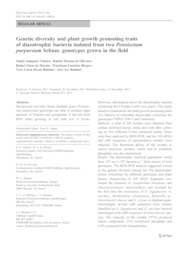Genetic diversity and plant growth promoting traits of diazotrophic bacteria isolated two Pennisetum purpureum Schum. Genotypes grown in the field.
Genetic diversity and plant growth promoting traits of diazotrophic bacteria isolated two Pennisetum purpureum Schum. Genotypes grown in the field.
Resumo: Background and aims Some elephant grass (Pennisetum purpureum) genotypes are able to produce large amounts of biomass and accumulate N derived from BNF when growing in soil with low N levels. However, information about the diazotrophic bacteria colonizing this C4 plant is still very scarce. This study aimed to characterize the plant growth promoting traits of a fraction of culturable diazotrophs colonizing the genotypes CNPGL F06-3 and Cameroon. Methods A total of 204 isolates were obtained from surface sterilized leaves, stems and roots after culturing on five different N-free semisolid media. These were then analyzed by BOX-PCR, and the 16S rRNA and nifH sequences of representative isolates were obtained. The functional ability of the isolates to reduce acetylene, produce indole and to solubilize phosphate was also determined. Results The diazotrophic bacterial population varied from 102 up to 106 bacteria g?1 fresh tissues of both genotypes. The BOX-PCR analysis suggested a trend in the genetic diversity among the 204 diazotrophic strains colonizing the different genotypes and plant tissues. Sequencing of 16S rRNA fragments confirmed the presence of Azospirillum brasilense and Gluconacetobacter diazotrophicus and revealed for the first time the occurrence of G. liquefaciens, G. sacchari, Burkholderia silvatlantica, Klebsiella sp., Enterobacter cloacae and E. oryzae in elephant grass. Interestingly, several nifH sequences from isolates identified as G. liquefaciens and G. sacchari showed homologies with nifH sequences of Enterobacter species. The majority of the isolates (97%) produced indole compounds, 22% solubilized phosphate and 6.4% possessed both characteristics.
Ano de publicação: 2012
Tipo de publicação: Artigo de periódico
Unidade: Embrapa Amapa
Observações
1 - Por padrão são exibidas publicações dos últimos 20 anos. Para encontrar publicações mais antigas, configure o filtro ano de publicação, colocando o ano a partir do qual você deseja encontrar publicações. O filtro está na coluna da esquerda na busca acima.
2 - Para ler algumas publicações da Embrapa (apenas as que estão em formato ePub), é necessário ter, no celular ou computador, um desses softwares gratuitos. Sistemas Android: Google Play Livros; IOS: iBooks; Windows e Linux: software Calibre.
Acesse outras publicações
Acesse a Base de Dados da Pesquisa Agropecuária (BDPA) para consultar o acervo completo das bibliotecas da Embrapa.

